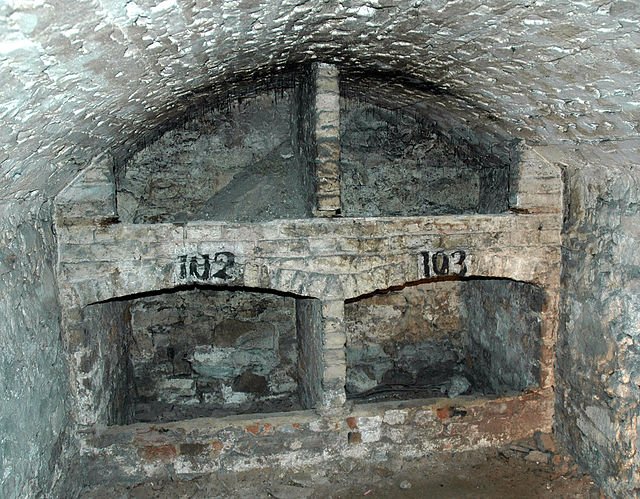A long-buried mini-city beneath the streets of Edinburgh sheds light on the lives of its 19th century poor
The Edinburgh Vaults. fw42, CC BY 2.0
The city of Edinburgh is known for its gorgeous architecture, rich history and fascinating culture, and over many years has become a prime destination for tourists visiting Scotland. But beneath the Royal Mile lie hidden catacombs and an unsettling history of poverty and crime.
Despite being used as a prime spot for chintzy “ghost tours”, the underground city (referred to varyingly as the Edinburgh Vaults and South Bridge Vaults) has a rich and tragic history. It was constructed back in 1788 as part of the South Bridge Act, which was an attempt to make the rapidly-growing city more traversable. The bridge wasn’t only for travel, however; the arches under the bridge were home to tenement buildings designed to turn the area into a marketplace. The nearly 120 individual vaults became taverns, workshops and storage units for merchants.
Storage in the Edinburgh Vaults. Kjetil Bjornsrud, CC BY-SA 2.5
However, these vaults were not properly sealed against water and eventually started to flood, leading to most businesses completely abandoning them before the turn of the century. The rooms were left largely empty as the Industrial Revolution swept across Britain, and eventually became slum housing for the city’s poor. As jobs began to be automated, more and more citizens were without income and found themselves unable to pay for their homes, sending them out onto the streets and, eventually, down to the South Bridge Vaults.
Since the vaults were almost totally blocked off, many of them were without air circulation and sunlight. This, coupled with a lack of running water and sanitation, made living down in the vaults a waking nightmare. Over time, the vaults became more and more crowded, with many housing several families at once.
A recreation of living conditions in the Vaults. Shadowgate, CC BY 2.0
The vaults were also entirely avoided by the city police. As a result, they became a hotspot for all kinds of crime, from theft and prostitution to murder and body snatching. Rumors have circulated for years that a pair of notorious serial killers used the vaults to store corpses that they would later sell to medical schools for use in classes. While the killings did occur, there is no evidence that the criminals actually used the vaults to store their victims.
It is unknown exactly when the vaults were finally shut down. At some point, they were cleared out and sealed off with rubble to prevent new inhabitants. The vaults were left completely forgotten underneath the city until being discovered and excavated in the 1980s. In the years since, various clubs and venues have taken up residence in the vaults, but the vast majority are still used for ghost tours.
The history of these vaults is overshadowed by the pop-culture appeal of their supposed hauntings, but their very existence shines a light on the grim conditions faced by the poor in the 19th century. The appalling conditions in which these impoverished people lived is bad enough, but the indifference shown by the city’s government was far worse, letting criminals run rampant and leaving entire families essentially trapped in the sunless, disease-ridden catacombs. Today, the vaults serve as a reminder of the shortcomings of industrialism and the suffering endured by the poor around the world throughout history.
Though much of the vault network is still closed off to the public, there are many different tour companies in the city that guide visitors through the accessible rooms. Despite being billed most often as “ghost tours,” the guides are more than receptive to questions about the vaults’ history and tend to spend just as much time describing the vaults themselves as the ghosts that ostensibly still haunt them. Mercat Tours, a well-regarded historical tour company in Edinburgh, does adults-only evening tours regularly, with ticket prices around $28.
Ryan Livingston
Ryan is a senior at The College of New Jersey, majoring in English and minoring in marketing. Since a young age, Ryan has been passionate about human rights and environmental action and uses his writing to educate wherever he can. He hopes to pursue a career in professional writing and spread his message even further.




